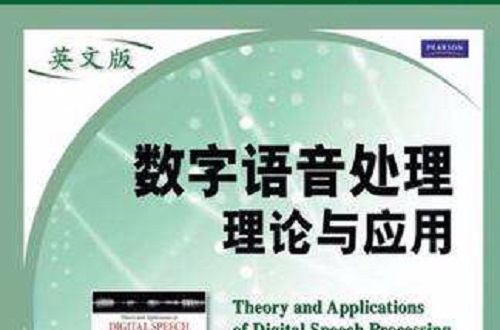《數字語音處理理論與套用》是2011年電子工業出版社出版的圖書,作者是美國)勞倫斯 R.拉比納(Lawrence R. Rabiner) (美國)羅納德 W.謝弗(Ronald W. Schafer)
基本介紹
- 書名:數字語音處理理論與套用
- 出版社:電子工業出版社
- 出版時間:2011年1月1日
- 裝幀:平裝
圖書信息,作者簡介,內容簡介,目錄,
圖書信息
出版社: 電子工業出版社; 第1版 (2011年1月1日)
外文書名: Theory and Applications of Digital Speech Processing
叢書名: 國外電子與通信教材系列
平裝: 1042頁
正文語種: 英語
開本: 16
ISBN: 7121124092, 9787121124099
條形碼: 9787121124099
尺寸: 23.4 x 18.4 x 4.4 cm
重量: 1.4 Kg
作者簡介
作者:(美國)勞倫斯 R.拉比納(Lawrence R. Rabiner) (美國)羅納德 W.謝弗(Ronald W. Schafer)
勞倫斯 R.拉比納(Lawrence R.Rabiner),美國工程院和美國科學院院士,美國聲學學會、IEEE、Bell實驗室、AT&T會士,以及Eta Kappa Nu、Sigma Xi、Tau Beta Pi等榮譽學會會員。曾擔任美國聲學學會副主席、IEEE Trans.ASSP主編和IEEE Proceedings編委會成員。其主要研究方向包括:通信、控制與信號處理、數位訊號處理、數字語音處理、多媒體通信、多模態處理等。Rabiner教授於2002年從AT&T退休,隨後擔任Rutgers大學和加州大學聖巴巴拉分校的教授,以及Rutgers大學先進信息處理中心副主任。
內容簡介
《數字語音處理理論與套用(英文版)》是作者繼1978年版經典教材《語音信號數字處理》之後的又一著作,全書除有簡練精闢的基礎知識介紹外,系統介紹了近30年來語音信號處理的新理論、新方法和在套用上的新進展。全書共14章,分四部分:第一部分介紹語音信號處理基礎知識,主要包括數位訊號處理基礎、語音產生機理、(人的)聽覺和聽感知機理和聲道中的聲傳播原理;第二部分介紹語音信號的時頻域表示和分析;第三部分介紹語音參數估計算法;第四部分介紹語音信號處理的套用,主要包括語音編碼、語音和音頻信號的頻域編碼、語音合成、語音識別和自然語言理解。
目錄
Preface
CHAPTER 1 Introduction to Digital SpeechProcessing
1.1 The SpeechSignal
1.2 The SpeechStack
1.3 Applicationsof Digital SpeechProcessing
1.4 Commentonthe References
1.5 Summary
CHAPTER 2 Reviewof Fundamentalsof DigitalSignalProcessing
2.1 Introduction
2.2 Discrete-Time Signals and Systems
2.3 Transform Representation of Signals and Systems
2.4 Fundamentalsof DigitalFilters
2.5 Sampling
2.6 Summary
Problems
CHAPTER 3 Fundamentalsof Human SpeechProduction
3.1 Introduction
3.2 The ProcessofSpeechProduction
3.3 Short-TimeFourierRepresentationofSpeech
3.4 AcousticPhonetics
3.5 DistinctiveFeaturesof thePhonemesof American English
3.6 Summary
Problems
CHAPTER 4 Hearing,Auditory Models,and SpeechPerception
4.1 Introduction
4.2 The SpeechChain
4.3 Anatomy andFunctionof theEar
4.4 The Perception of Sound
4.5 Auditory Models
4.6 Human SpeechPerceptionExperiments
4.7 MeasurementofSpeechQualityand Intelligibility
4.8 Summary
Problems
CHAPTER 5 Sound Propagationinthe HumanVocalTract
5.1 The AcousticTheoryofSpeechProduction
5.2 LosslessTube Models
5.3 Digital Models forSampled SpeechSignals
5.4 Summary
Problems
CHAPTER 6 Time-DomainMethods for SpeechProcessing
6.1 Introduction
6.2 Short-TimeAnalysisofSpeech
6.3 Short-TimeEnergyand Short-TimeMagnitude
6.4 Short-TimeZero-Crossing Rate
6.5 The Short-TimeAutocorrelation Function
6.6 The Modied Short-TimeAutocorrelation Function
6.7 The Short-TimeAverage Magnitude DifferenceFunction
6.8 Summary
Problems
CHAPTER 7 Frequency-DomainRepresentations
7.1 Introduction
7.2 Discrete-TimeFourierAnalysis
7.3 Short-TimeFourierAnalysis
7.4 SpectrographicDisplays
7.5 OverlapAddition Methodof Synthesis
7.6 Filter Bank SummationMethodof Synthesis
7.7 Time-DecimatedFilter Banks
7.8 Two-ChannelFilter Banks
7.9 Implementationof theFBS Method Usingthe FFT
7.10 OLARevisited
7.11 Modicationsof theSTFT
7.12 Summary
Problems
CHAPTER 8 TheCepstrumand Homomorphic SpeechProcessing
8.1 Introduction
8.2 HomomorphicSystems forConvolution
8.3 HomomorphicAnalysisofthe SpeechModel
8.4 Computingthe Short-TimeCepstrumand ComplexCepstrum of Speech
8.5 HomomorphicFilteringofNatural Speech
8.6 CepstrumAnalysisofAll-Pole Models
8.7 CepstrumDistanceMeasures
8.8 Summary
Problems
CHAPTER 9 Linear Predictive Analysisof SpeechSignals
9.1 Introduction
9.2 Basic Principles of Linear Predictive Analysis
9.3 Computationofthe Gainfor theModel
9.4 FrequencyDomainInterpretationsof Linear PredictiveAnalysis
9.5 Solutionofthe LPCEquations
9.6 The Prediction ErrorSignal
9.7SomePropertiesofthe LPCPolynomial A(z)
9.8 RelationofLinear Predictive Analysisto LosslessTube Models
9.9 Alternative Representationsof theLPParameters
9.10Summary 560Problems
CHAPTER 10 Algorithms for Estimating SpeechParameters
10.1 Introduction
10.2 MedianSmoothing and SpeechProcessing
10.3 Speech-Background/SilenceDiscrimination
10.4 ABayesianApproach toVoiced/Unvoiced/Silence Detection
10.5 Pitch Period Estimation(Pitch Detection)
10.6 Formant Estimation
10.7Summary 645Problems
CHAPTER 11 DigitalCodingof SpeechSignals
11.1 Introduction
11.2 Sampling SpeechSignals
11.3 AStatisticalModelfor Speech
11.4 Instantaneous Quantization
11.5 AdaptiveQuantization
11.6 QuantizingofSpeechModelParameters
11.7 GeneralTheoryof DifferentialQuantization
11.8 Delta Modulation
11.9 DifferentialPCM (DPCM)
11.10 Enhancements forADPCM Coders
11.11 Analysis-by-Synthesis SpeechCoders
11.12 Open-Loop SpeechCoders
11.13 Applicationsof SpeechCoders
11.14Summary 819Problems
CHAPTER 12 Frequency-DomainCodingof SpeechandAudio
12.1 Introduction
12.2 HistoricalPerspective
12.3 Subband Coding
12.4 AdaptiveTransform Coding
12.5 APerception ModelforAudioCoding
12.6 MPEG-1AudioCoding Standard
12.7 OtherAudioCoding Standards
12.8Summary 894Problems
CHAPTER 13 Text-to-SpeechSynthesis Methods
13.1 Introduction
13.2 Text Analysis
13.3 Evolutionof SpeechSynthesis Methods
13.4 Early SpeechSynthesis Approaches
13.5 UnitSelection Methods
13.6 TTS Future Needs
13.7 Visual TTS
13.8Summary 947Problems
CHAPTER 14 Automatic SpeechRecognition andNatural Language Understanding
14.1 Introduction
14.2 Basic ASRFormulation
14.3 Overall SpeechRecognition Process
14.4 Buildinga SpeechRecognition System
14.5 The DecisionProcessesinASR
14.6 Step3:The Search Problem
14.7 SimpleASR System: IsolatedDigit Recognition
14.8 Performance Evaluationof SpeechRecognizers
14.9 SpokenLanguage Understanding
14.10 Dialog Managementand SpokenLanguage Generation
14.11 User Interfaces
14.12 MultimodalUserInterfaces
14.13Summary 984Problems
Appendices
A Speechand Audio Processing Demonstrations
B Solution of Frequency-Domain Differential Equations
Bibliography
Index

